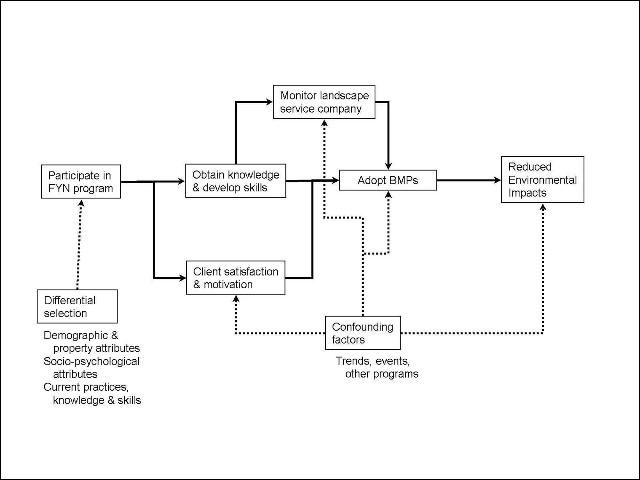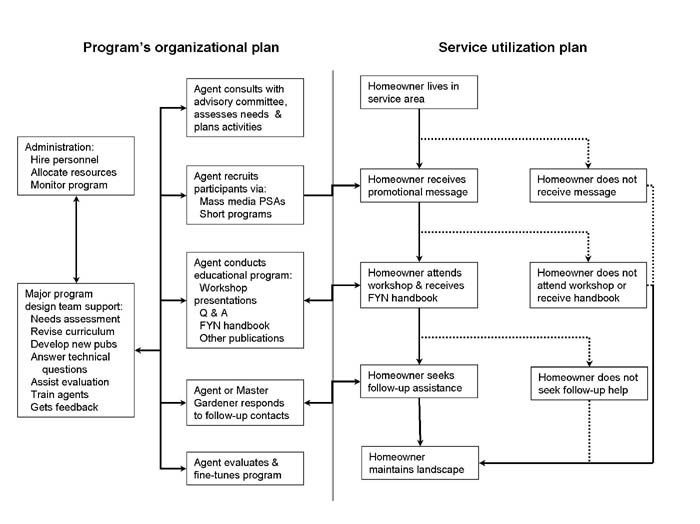Developing an effective Extension program is not easy. Factors that can affect the quality of a program include needs of clientele, content and sequence of educational activities, and availability of resources and coordination among county faculty, state specialists, and administrators. In essence, an effective Extension program gets the right information to appropriate clients in a way that they can understand and apply. One useful tool to help us plan an effective Extension program is the logic model. Logic models identify program outcomes, processes in which clients are to engage, and the organizational structure for delivering educational activities. Well-conceived logic models are based on relevant disciplinary research and developed in consultation with other faculty.
Logic models help us to think through our plans for the program. The reason logic models can help is that the process of developing a model forces us to make assumptions explicit about how the program will work. A logic model also can help us communicate more clearly with our colleagues and peers about the internal workings of the program. We need to "start with the end;" that is, start with a focus on the outcomes that clients need to achieve. Then we work back to identify the steps necessary to achieve these outcomes, and by doing so, we can better ensure that they will occur.
What is a logic model?
Logic models are diagrams that show the major components of a program. Arrows are used to link the components of the model to reflect the sequence of events necessary for the program to be effective. Figure 1 shows a logic model for the food handler training component of Florida's food safety program. In addition to the diagram, logic models can include a narrative that explains the relationships between these components. Fully specified logic models also identify the external factors that can hinder the efforts of program staff or help them achieve the program's objectives. The logic model may also indicate factors that affect recruiting participants into the program. A well-reasoned logic model draws upon disciplinary knowledge bases to establish the likely outcomes of program activities and factors that can help or hinder Extension's effort.

There are several different types of logic models. The most common type is the outcome sequence model (Hatry, 1999) or impact theory model (Rossi, Lipsey, & Freeman, 2004). The focus of this type of model is on describing outcomes that are caused by the program. In addition, outcome models are often used as a basis for identifying a program's performance measures because components which are important enough to include in the model should also be the focus for performance measurement (Hatry, 1999). A second type of model, the process theory model, describes the interaction between program staff and participants, as well as the internal organization of the program (Rossi, Lipsey, & Freeman, 2004).
Steps for Creating a Logic Model
Identify Important Outcomes
The first step is to identify the major components of the program's outcomes. These outcomes may be short-term, intermediate, or long-term. Long-term outcomes include changes in social, economic, and environmental conditions (SEEC; see Rockwell & Bennett, 2004). For example, one long-term, social outcome for the food safety program in Figure 1 is the improved health status (fewer illnesses) of consumers who patronize the businesses operated by program participants. A long-term, economic outcome of a commodity-focused program might be in increase in net profit for the producer. Changing environmental conditions might include, for example, the reduction of nitrates in groundwater or the restoration of in ecosystem's water quality.
Intermediate outcomes usually include the adoption of best management practices (BMPs) and appropriate technologies. More importantly, intermediate outcomes may include combinations or sets of practices and technologies. For example, the food safety program shown in Figure 1 might focus on BMPs that are necessary for implementing Hazard Analysis Critical Control Point (HACCP) plans, and include practices that must be adopted as a set in order to be effective. Likewise, Integrated Pest Management (IPM) requires the use of multiple BMPs to be effective, so program objectives should be focused on complete, rather than "partial," adoption.
Finally, short-term outcomes may be changes in knowledge, attitudes, and skills. Because participation in Extension programs is voluntary, the number of participants, intensity of participation, and satisfaction with the program also are considered by some experts to be aspects of short-term outcomes (Hatry, 1999).
For many programs, some audience segments or groups may have outcomes different from other groups. This is because needs vary: one group of clients needs information on one topic, a second group needs information on a related but different topic, and a third group may need information on an array of topics. In this situation, developing a logic model for each group can help focus the program to deliver the needed information to the appropriate group.
Create a Logical Sequence of Events
The second step in creating a logic model is to organize the outcomes in a sequence or chain of events and to identify external factors that can hinder or facilitate the program. Fundamentally, the sequence of outcomes is based on expectations about cause and effect relationships between program activities and short-term outcomes, short-term and intermediate outcomes, and intermediate and long-term outcomes (Rossi, Lipsey, & Freeman, 2004). For some programs, the linkage between program activities and outcomes also may include feedback loops.
For example, Figure 2 shows an impact model for the Florida Yards and Neighborhoods (FYN) nitrate BMP Extension project (Israel & Hague, 2002), which was focused on reducing nitrates and groundwater in two Central Florida counties. The primary long-term outcome is to reduce environmental impacts, specifically the amount of nitrates entering groundwater from homeowners' landscaping activities. Reducing nitrates, according to the logic model, should follow the adoption by homeowners of best management practices (BMPs), such as applying one pound of nitrogen per thousand square feet of turfgrass.

The adoption of BMPs should occur as homeowners obtain knowledge and develop the new skills for maintaining the landscape. For those who use a lawn care service company, adoption of BMPs may also require that homeowners monitor what the company does and use BMPs in choosing a lawn care service company.
The logic model in Figure 2 also shows that the program may not cause the desired outcomes for two reasons. First, clients who already use the recommended BMPs may participate in FYN programs that Extension conducts. In this case, people who do not need the program will be using resources intended for those who do. Even among clients who need the program, some groups might be more likely to participate than others (this is referred to as "differential selection"). Second, other clients may both attend Extension programs and receive information from other sources. In the case of this group, the reason they adopt BMPs may be due to the information from other agencies rather than Extension. Though this outcome is desirable from the standpoint of achieving environmental quality, the program wasn't sufficient to have caused the impact.
The specification of the logic model in Figure 2 was based on an environmental education model developed by Hines, Hungerford, & Tomera (1987). This model was supplemented by research findings from psychology, sociology, and other disciplines (Israel & Hague, 2002).
Specify the Process Theory
The third step in developing a logic model is to specify the process theory. The process theory has two main components: the program's service utilization plan and its organizational plan. The service utilization plan is a flow-chart that shows how clients (or specific groups of clients) become engaged in the program's activities. The key idea is to describe how the program involves the client from his or her perspective (Rossi, Lipsey, & Freeman, 2004). This includes indicating the initial contact with the client to recruit him or her to participate in the program, the set of activities through which the client obtains information, and follow-up activities that reinforce the educational process and encourage adoption of BMPs and technologies. The service utilization plan should answer the question about whether the program engages the client in a way that is suf- ficient to initiate the sequence of outcomes specified in the impact theory. For example, Figure 3 illustrates the service utilization plan for the Florida Yards and Neighborhoods program in Central Florida. Notice that there are several points at which potential clients may not be engaged in the program. By identifying these points, Extension faculty can develop strategies to maximize client's recruitment, retention, and completion. The plan shown in Figure 3 is relatively simple; those for other programs having multiple audiences can be more complex.

The program's organizational plan includes the major components or factors involved in the program. It also indicates how resources (e.g., curriculum, publications, expense money, specialized equipment, and personnel) are obtained and deployed, as well as relationships among key actors (Rossi, Lipsey, & Freeman, 2004). Having adequate resources and an effective organization are important factors in delivering a high-quality program to clients. In Extension's case, the actors include program teams who design a comprehensive set of activities, relevant administrators, and other county and state faculty who participate in the program. The organizational plan also indicates the roles or responsibilities, as well as the required expertise, that each actor has. In other words, the organizational plan should answer the question "What do agents, specialists, and program teams do and why?" Figure 3 also illustrates the organizational plan for the FYN nitrate BMP Extension project. Not shown in the figure are additional details, such as the specific curriculum used or publication topics to be developed by specialists.
These details should be identified in an accompanying narrative. In sum, the development of the process theory can be used as a blueprint for the plan of action. It identifies which faculty are to conduct specific activities and what sequence of activities should be conducted.
Obtain Comments from Others
The fourth step is the review and consultation process. Though the initial development of logic models can be quickly completed by a small group of individuals, much can be gained by involving the full membership of program teams, collaborating county and state faculty, interested administrators, and external peers. Broad-based involvement helps to ensure that the model is correctly specified and based on relevant research. More importantly, participants will be more likely to share a commitment to the program's objectives and activities, even if these may lie outside his or her expertise.
Concluding Comments
For logic models to serve a useful function, it is important to begin by specifying the program's desired outcomes and then work back. Starting with the program's current activities can lead to maintaining the status quo instead of engaging in a careful, research-based discussion of the rationale for the program (Hatry, 1999). Creating a logic model helps faculty to focus the educational program on generating outcomes for clients and including the necessary components for their attainment. With the completion of a detailed logic model, faculty can be confident that their efforts will be effective and their resources well spent. The time spent developing a logic model should be viewed as an investment rather than an expense. Given the public's expectations for performance, faculty can ill afford not to use logic models as a tool for program planning.
References
Hatry, Harry P. (1999). Performance Measurement: Getting Results. Washington, DC: The Urban Institute Press.
Hines, J.M., Hungerford, H.R., and Tomera, A.N. (1987). Analysis and synthesis of research on responsible environmental behavior: A meta-analysis. Journal of Environmental Education, 18(2), 1–8. https://doi.org/10.1080/00958964.1987.9943482
Israel, Glenn D. and Glenn Hague. (2002). The Challenge of Environmental Education: A Comparison of Nonparticipants and Participants in Homeowner Landscaping Programs. Journal of Agricultural Education, 43(4), 76–87. https://doi.org/10.5032/jae.2002.04076
Rockwell, K., & Bennett, C. (2004). Targeting outcomes of programs: A hierarchy for targeting outcomes and evaluating their achievement. Retrieved from https://digitalcommons.unl.edu/aglecfacpub/48/
Rossi, P. H., Lipsey, M. W., and Freeman, H. E. (2004). Evaluation: A systematic approach (7th ed.). Newberry Park, CA: Sage Publications.